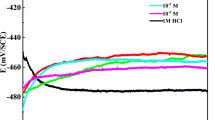Abstract
Cationic release, surface microstructure, and pore size distribution of coal gangue during the acid-based chemical solution corrosion were investigated. Results showed that during the interactions of gangue and chemical solution, the acidity and alkalinity of mixed solutions first decrease quickly, and then stabilize. The concentrations of released Ca, Mg, and Fe in gangue decrease with the decreasing acidity of the chemical solution, and produce a trend of increase-to-decrease with the increase in alkalinity. The release of Ca, Mg, and Fe is significantly influenced by the weathering of gangue. Ca and Mg achieve a concentrated release during the first day, whereas the release of Fe occurs gradually within the first 10 days. The microstructure detection result indicates that the surface structure of fresh gangue is exposed to obvious corrosion by acid-based chemical solutions, with higher extent of corrosion in acidic solution than that in alkaline solution. The micropore is relatively developed, and the secondary and middle pores increase gradually. The specific surface area is increased. Furthermore, the pore size distribution of abundance of micropore and middle pore shows a series of inconsistent spectra instead of a continuous wide-flat spectrum.







Similar content being viewed by others
References
Dang Z, Martin H, Watts SF, Wan G, Li D (1996) Coal mine spoil-water interaction: II. Weathering concentrated metals in surface coal mine spoils. Sci China (Ser D) 39(6):610–617
Dang Z, Liu CQ, Li Z (2001) Experimental simulation of chemical activity of heavy metals in coal gangue. J S China Univ Technol (Nat Sci Edn) 29(12):1–5
Demers I, Bussière B, Benzaazoua M, Mbonimpa M, Blier A (2008) Column test investigation on the performance of monolayer covers made of desulphurized tailings to prevent acid mine drainage. Miner Eng 21(4):317–329
Fallman A (1997) Performance and design of the availability test for measurement of potentially leachable amounts from waste materials. Environ Sci Technol 31:735–744
Fan YG, Li YH, Ma JB (2002) Mesoporous properties of porous crosslinked polystyrene absorbents. Chem J Chin Univ 8:1622–1626
Fu T, Wu Y, Ou L, Yang G, Liang T (2012) Effects of thin covers on the release of coal gangue contaminants. Energy Procedia 6:327–333
Hareeparsad S, Tiruta-Barna L, Brouckaert CJ, Buckley CA (2001) Quantitative geochemical modelling using leaching tests: application for coal ashes produced by two South African thermal processes. J Hazard Mater 186(2–3):1163–1173
Jiang Y, Duan Y, Yang X, Yang L, Wang Y (2007) Adsorption characterization of coal fired flue gas mercury by ESP fly ashes. J Southeast Univ (Nat Sci Edn) 37(3):436–440
Kim JJ, Kim SJ (2004) Seasonal factors controlling mineral precipitation in the acid mine drainage at Donghae coal mine, Korea. Sci Total Environ 325(1–3):181–191
Li C, Wan J, Sun H, Li L (2010) Investigation on the activation of coal gangue by a new compound method. J Hazard Mater 179(1–3):515–520
Liu ZY, Zheng JT, Wang MZ, Zhang B (2001) Study for nitrogen adsorption of PAN-based activated carbon fibers. Acta Phys Chim Sin 17(7):594–599
Palme CA, Krasnow M (1993) An evaluation of leaching determine modes of occurrence selected toxic elements in coal. J Coal Qual 12(4):135–141
Shaw SC, Gorat LA, Jambor JL, Blowes DW, Hanton-Fong CJ, Stuparyk RA (1998) Mineralogical study of base metal tailings with various sulfide contents oxidized in laboratory. Environ Geol 33(2–3):209–217
Song X, Gong C, Li D (2004) Study on structural characteristic and mechanical property of coal gangue in activation process. J Chin Ceram Soc 32(3):358–363
Wang M, Zhang J, Zhang S, Wu J, Yue G (2008) Effect of pyrolysis conditions on the char surface area and pore distribution. J China Coal Soc 33(1):76–79
Wu X, Hao Q, Fan S (2009) Discussion on hazardous trace elements precipitation process in coal gangue. Coal Geol Explor 37(4):43–46
Zhang N, Sun H, Liu X, Zhang J (2009) Early-age characteristics of red mud-coal gangue cementitious material. J Hazard Mater 167(1–3):927–932
Zielinski RA, Otton JK, Johnson CA (2001) Sources of salinity near a coal mine spoil pile, North-Central Colorado. J Environ Qual 30(4):1237–1248
Acknowledgments
This research was supported by the National Basic Research Program of China (973 Program) (2012CB719802); the National Natural Science Foundation of China (51279199, 50927904, 5079143); the National Water Pollution Control and Management Science and Technology Major Projects of China (2012ZX07104-002); Wuhan high and new technology achievements transformation and industrialization project (2013060803010403).
Author information
Authors and Affiliations
Corresponding author
Rights and permissions
About this article
Cite this article
Xue, Q., Lu, H., Zhao, Y. et al. The metal ions release and microstructure of coal gangue corroded by acid-based chemical solution. Environ Earth Sci 71, 3235–3244 (2014). https://doi.org/10.1007/s12665-013-2743-y
Received:
Accepted:
Published:
Issue Date:
DOI: https://doi.org/10.1007/s12665-013-2743-y




